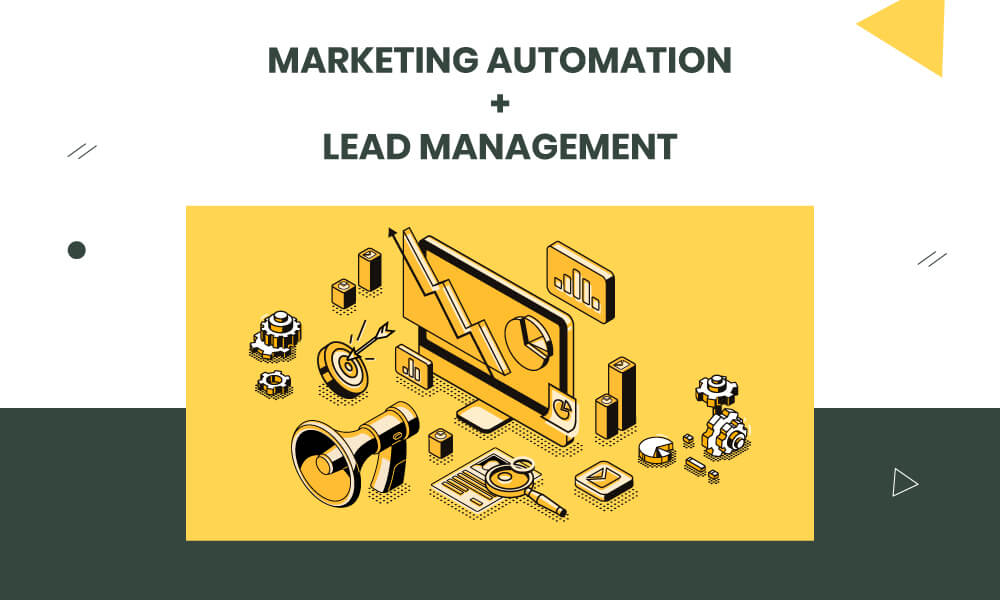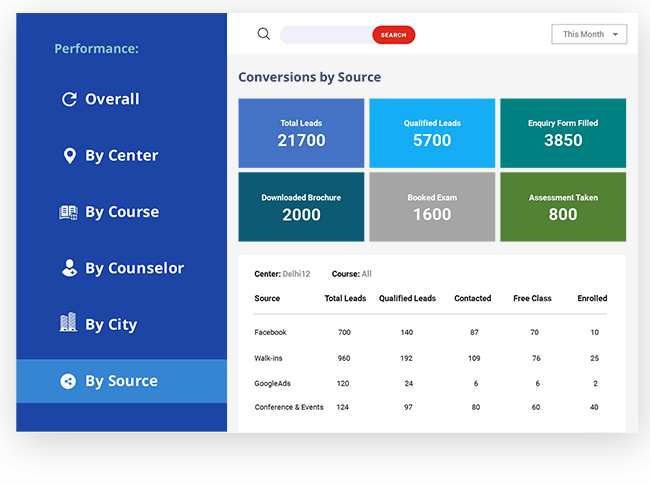Converting contacts or leads into customers is a top priority for every organization. However, companies have struggled with lead nurturing and pushing them down the sales funnel for a long time.
Previously, businesses had two teams for generating customers: the marketing team for advertising and promoting products/services and the sales team for managing leads and nurturing them into customers. Generally, it looked easy when both had their dedicated roles and responsibilities. But the problem arose when they did not work together. So, disagreements and frustrations became the order of the day. They had no clear and consistent strategy. The lack of aligned goals made it tricky to harness quality leads and sales.

Soon businesses realized that they need to align their sales and marketing processes. Hence, the concept of marketing automation lead management came into the picture. It unifies the gap between sales and marketing by creating a connected process. That way, they were able to drive positive and remarkable outcomes with less human effort and disparities. Plus, the line between the two functions and the two processes have also blurred. That is, lead generation to closure is not a straight line as it may seem. Several things happen simultaneously, so both the teams need to be in the loop, with the right team intervening whenever necessary.
So, how do you start marketing automation for lead management? This article talks about critical marketing automation steps for business growth.
In this article:
Marketing Automation + Lead Management: Combined Benefits
Over 75% of marketers now use automation of some sort. 77% of them have watched conversions grow after switching to automated systems. Marketing automation is one of the best ways to automate lead responses for a business.
Now, your lead management process will have many stages depending on your business type and goals. However, it is always better to cut it down to a simple intent-based communication. Such workflow warms up visitors using specific content and qualifies them as prospects. Here, we present a simple marketing automation lead management strategy using email marketing automation.
1. Drive visitors to opt-in to your email list
Suppose you have a website or social account or both that receives traffic. Then you might want to capture the email addresses of your visitors. To do so, you can consider giving away content. There are many ways to achieve this, but lead magnets are most popular.
Lead magnets include eBooks, free reports, checklists, white papers, case studies, and more. Regardless, make sure you have a clear content strategy. You want to make sure that your visitors cannot resist your content. It should be relevant enough that they want to learn more in the end.
2. Deliver on your promise
Once users offer their emails, you must begin the interactive stage. The best way to start is to send them the content you suggested on your website or ads. Ensure you deliver precisely that piece of content that they wanted in the first stage. Most brands send these content pieces with a welcome email to jump-start the conversation. It is a recommended process that helps you set the tone without coming off as pushy or aggressive.
3. Nurture your leads
Your marketing automation makes a difference at this point. You do not want all kinds of leads. Your goal is to achieve high-quality, engaged, and qualified leads.
Using marketing automation, you may already have created a list of leads. Re-engagement helps filter the low-interest subscribers from highly motivated and interested prospects. At this stage, you need to earn their trust by offering a wealth of knowledge. Your reach becomes more effective if you understand their pain points and can help. When subscribers download or go for the extra content, your marketing automation moves them to a new list or category or even marks their progress in the sales funnel.
Nurturing leads does not mean sending only ebooks or whitepapers from time to time. You need to engage with them in many other ways. For instance, you can invite them for a webinar, ask them to participate in a survey, conduct live Q/A sessions, and aid their critical problems.

Now, how will you come to know that a lead is ready to go down the funnel? Should SDRs (Sales Development Representatives) make a call, or should they wait further? You can gauge this by assigning a lead score based on their engagement. For instance, if the lead registers for a webinar, then add the lead score. If the lead unsubscribes from your mailing list, then subtract the score. After the score crosses a threshold, pass them to your SDRs.
The best thing about this process is – until the leads become sales-ready, you need not intervene at all. Organizations generally use CRM (Customer Relationship Management) system to automate such workflows and sync sales and marketing teams.
4. Transfer warm leads to sales
When you have segmented and identified your warmest leads, your sales team can take over. Your marketing automation should be able to notify your sales staff about this. Such automation leads to faster and easier follow-ups.
5. Warm up cold leads with re-engagement campaigns
It is common to have contacts that have not engaged with you for a long time. These are cold leads. However, do not discard these inactive leads from your list. Because marketers know how much time and effort it takes to build the mailing list.
Before running a re-engagement campaign, check:
- Is the email id correct?
- Is the contact still actively using the email id?
- Has the lead opened your email previously but did not interact?
By creating rules on your marketing automation suite, you can filter such contacts. Filtering contacts will also give you clear metrics of your re-engagement campaign.
You can create content tailored to warm up these leads over time. Most brands consider sending insightful email content weekly or monthly. That way, you can keep your brand and products fresh on their mind.
6. Repeat and improve
All marketers know the vitality of tracking and testing. So, even with positive results, you still need to refine, score, and improve your strategy. Testing helps you make the right adjustments to achieve more wins. Naturally, Marketing automation campaigns can provide deeper insights. Therefore, you should make sure to:
- Measure sales performance,
- Evaluate your marketing and sales ROI
- Track and assess the entire sales cycle
Test more to figure out what works for your business. Over time, you will achieve seamless lead management. It will eventually translate to more leads, sales, and better business results.
Why Marketing Automation for Lead Management?
There is so much that unified marketing automation and lead management processes can achieve for your business. It can allow you to take control of lead generation and nurturing to actual sales when they are ready to buy.
Marketing automation also handles repetitive tasks. So, your marketing and sales team waste no more time on these tasks. There are many more reasons to use marketing automation lead management. Such as:
1. Combined use of marketing collateral
Remember that nurturing every single lead takes an awful amount of time. Today, marketers combine content marketing, landing pages, email marketing SEO, lead nurturing, and social media advertising.
Each of these sometimes requires a different path, software, or mechanism. A scattered approach makes it impossible to focus on the most important goal.
By using marketing automation for lead management, you can repurpose the collateral, update the leads about eventful activities, and more. It also helps you nurture leads on a more manageable scale while still personalizing interactions. Over 70% of brands report that highly personalized customer communication is the most important benefit of automation.
2. Accurate focus
Marketing automation helps your sales and marketing teams set precisely defined phases. Together, they can also create an agreed buyer profile to streamline your campaigns. Furthermore, your teams will also be able to maintain a laser focus on your goals. They will also continuously optimize your processes to gain higher conversion rates.
3. Higher revenue
The more you nurture your leads, the higher the chances of conversion. Marketing automation helps you personalize your interactions. Personalization increases the chances of conversions. Therefore, it becomes easier to achieve higher revenue in a short time.
4. Scalability
Marketing automation helps you scale your best responses to the directions leads take. It also helps maintain engagement as they move through the sales cycle. With marketing automation in place, you can review, track, and measure results on a wider scale.
5. Measure outcomes
One of the most useful use cases of marketing automation is to understand the sales cycle. The sales team wants to know how much time it takes to convert a marketing lead into a customer. With automation in place, you can track the entire customer journey – from the time of first interaction to final purchase and post-purchase opportunity management.

Choosing an Automated Marketing Solution
Our example focused on email marketing. However, marketing automation for lead management can take many forms. You can have digital marketing automation, social media marketing automation, chatbot marketing, advertising automation, mobile marketing automation, and CRM with marketing automation.
Each distinct group also has many forms. They depend on your business and chosen strategy.
The right step? Ensure you determine your ideal lead management path. It will help you choose the right marketing automation software. Make your selection of the best marketing automation lead management software holistically. Bear in mind that your choice should include all the following features:
- Email marketing workflows
- Customer Relationship Management (CRM) system
- Social Media Management
- Interactive forms and landing pages
- Multiple-User access for team collaboration
- Opportunity management
- Integration with telephony/cloud calling to draw complete marketing to sales picture.
Automate Your Lead Management and Grow Your Business
Marketing automation in lead management is an excellent idea. However, you will have a lot to learn first to figure out the best approach. Once you have got the hang of it, marketing automation will surely help you save time, money, and energy. With this, your sales and marketing teams will be able to eliminate routine tasks. They can better focus on establishing better customer relations.
The bottom line is – marketing automation is not just about nurturing leads and closing sales. It is also about creating personalized and relevant campaigns that resonate with your customers.
In the end, it is all about creating memorable experiences to make your customers loyal ambassadors.
How about taking LeadSquared marketing automation for lead management for a test spin?
Marketing Automation, Lead Management FAQs
Marketing automation is a technology for automating marketing activities and managing marketing campaigns across multiple channels. It helps businesses to target customers with automated messages across email, web, social, and text.
Lead automation streamlines a variety of touchpoints where leads can enter your sales funnel. It can include PPC campaigns, social media, landing pages, websites, phone calls, and more. When you generate leads, automation carries the task of nurturing them from time to time. Lead automation requires little to no human intervention for engaging with them and until they travel down the marketing funnel.
By using a marketing automation suite or CRM (Customer Relationship Management) software, you can easily automate lead responses. You can set triggers such as subscribed to email, requested eBook, made a phone call, submitted contact us form, and more and send a response accordingly.








